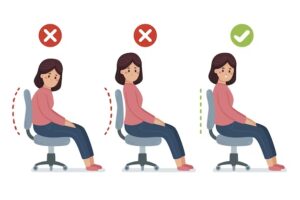The joints and discs in the neck are impacted by the frequent age-related disorder known as cervical spondylosis. It may also be referred to as cervical osteoarthritis or osteoarthritis of the neck. If neglected, this issue can cause nerve compression and other problems in addition to chronic neck pain and stiffness. The structure of the cervical spine, the distinction between cervical spondylosis and cervical kyphosis, and the management of this ailment with physiotherapy are all covered in this article. We’ll also go through our top five workouts for people with cervical spondylosis.
Let’s simplify this. The neck experiences wear and tear in cervical spondylosis. The term “wear and tear” is quite archaic and disliked by some physiotherapists. In actuality, though, everyone’s neck starts to ache as they get older. However, this deterioration can occur at various rates and intensities. Some people begin to experience it at the age of 30, while others may experience it much later.
The Cervical Spine’s Anatomy
Seven vertebrae are stacked on top of one another in the cervical spine. The discs that separate these vertebrae, which serve as shock absorbers and keep the neck in an upright position, also allow the neck to move. Facet joints also link the vertebrae.
How to determine whether your exercise intensity is appropriate
You can use this guide to determine your exercise intensity level. Additionally, it will enable you to determine how much suffering is tolerable.

If you give yourself a pain score of 0 to 10 (0 being no pain and 10 being the greatest agony you have ever experienced), for instance:
- 0 to 3 – little to no pain
- Acceptable pain is between 4 and 5.
- 6 to 10 – severe discomfort
Cervical kyphosis vs cervical spondylosis
When the discs and joints in the neck start to degrade as a result of wear and tear over time, it is known as cervical spondylosis. As a result, bone spurs may form, which could irritate the neck’s nerves and result in pain. The normal curvature of the neck is diminished in cervical kyphosis, in contrast, and the neck starts to bend forward. Numerous things, such as bad posture, trauma, or degenerative diseases like osteoporosis, might contribute to this.
Cervical Spondylosis Symptoms
Chronic neck discomfort, stiffness, and a restricted range of motion in the neck are some of the most typical signs of cervical spondylosis. Headaches, tingling or numbness in the hands or arms, and weakness in the arms or legs are other symptoms that some patients may encounter. Cervical spondylosis can damage nerves and result in more serious problems in severe situations.
Cervical Spondylosis Treatment
At Surrey Physio, we frequently meet patients who are successfully treated for cervical spondylosis with physiotherapy and osteopathy. Every few days, I would see scores of people with this. Based on your unique needs and goals, your Surrey Physiotherapist can create a treatment plan that is specifically tailored for you. Exercises to increase neck flexibility and range of motion as well as strengthening exercises to improve posture and lessen strain on the neck may be included in this. In order to reduce discomfort and increase mobility, a physiotherapist may also employ manual treatment techniques like massage or manipulation.
Other cervical spondylosis therapies could include painkillers and anti-inflammatory drugs, as well as surgery in extreme situations. However, because it may be so successful at lowering pain and enhancing function, physiotherapy and osteopathy are frequently the first line of treatment for cervical spondylosis.
The Importance of Physiotherapy in Cervical Spondylosis
Due to their ability to help with pain management and functional improvement without requiring intrusive procedures like surgery, physiotherapy and osteopathy are crucial for treating cervical spondylosis. Additionally, by enhancing posture and lessening tension on the neck, physical therapy can help to stop further degeneration of the neck. You can create a personalized treatment plan with the help of a physiotherapist that takes into account your particular needs and objectives and aids in improving your quality of life.
A Clinic for Physiotherapy to Attend
It’s crucial to pick a clinic with experience treating cervical spondylosis if you’re seeking for physiotherapy for this illness. Leading physiotherapy facility Surrey Physio is an expert in treating neck and spine disorders, including cervical spondylosis. Our group of skilled physical therapists can create a personalized treatment plan that is catered to your particular requirements and objectives. We employ a range of methods, including manual therapy, physical activity, and instruction.
Please attempt these exercises for now:
Ways to increase neck rotation
By looking over your left shoulder, progressively turn your neck to the left. Bring the range of your neck to a comfortable termination. Continue to the right. Make sure to maintain a relaxed back and shoulder. This is a great exercise to increase your neck’s mobility and rotation. 10 times on each side, repeat.
Levator scapulae stretching techniques
Take a forward neck bend, then side bend your neck by pointing your left ear in the direction of your left shoulder. To increase the strength of the stretch, hold onto a chair. You will be able to feel a stretch in the side and back of your neck as a result. By adding a hand to the stretch, you may make it more powerful. Repeat twice on each side while holding the stretch for 10 seconds.
Retraction of the Neck Isometric Pillow
Press your head against the pillow while maintaining a straight neck to produce some resistance. During the movement, your chin shouldn’t incline upward toward the ceiling. This exercise involves isometric neck extension. Ten times in total.
Manual therapy is a very effective way to treat cervical spondylosis, albeit it cannot be cured. Simply increasing the range of motion and mobilizing your neck always helps.
Conclusion
Although cervical spondylosis cannot be avoided, symptoms can be managed. A temporary soft neck brace or traction to gently extend the neck’s joints and muscles are just a few other physical therapy procedures that may be used. Discuss your alternatives with the DOC healthcare team if conservative therapy are unable to relieve your pain and stiffness. Steroid injections or surgery may be beneficial for those who experience developing neurologic symptoms such arm weakness, numbness, falling, or ongoing, excruciating pain.



















